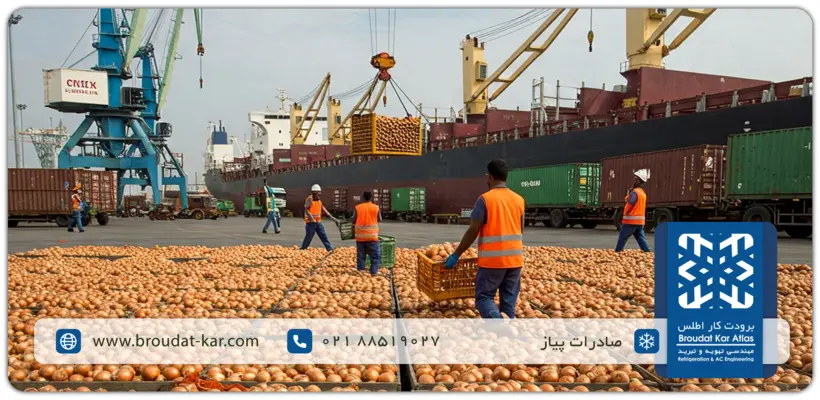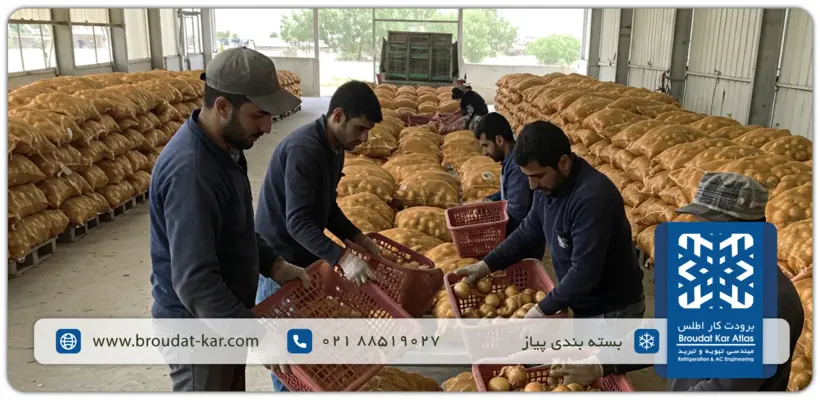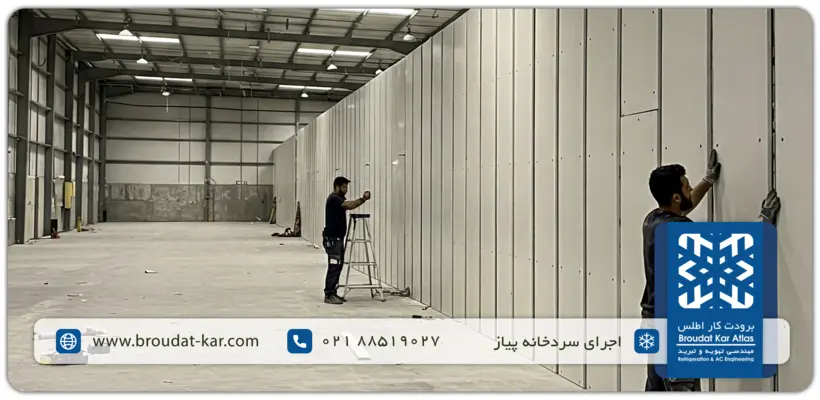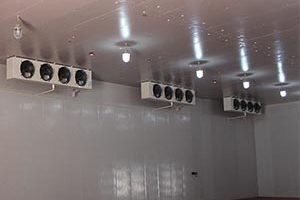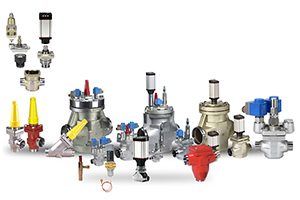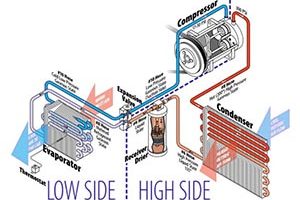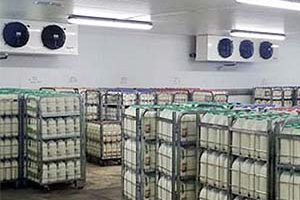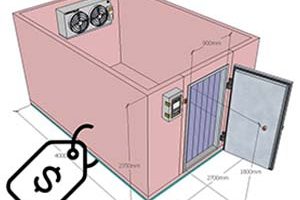Onion cold storage
Onion cold storage is regarded as the best method for the long-term preservation of this product. In the past, using traditional methods such as drying the onions and storing them in a basement or dark warehouse, the onions could be kept for a short period after harvest; however, these methods ultimately resulted in the spoilage of 40–80 percent of the onions.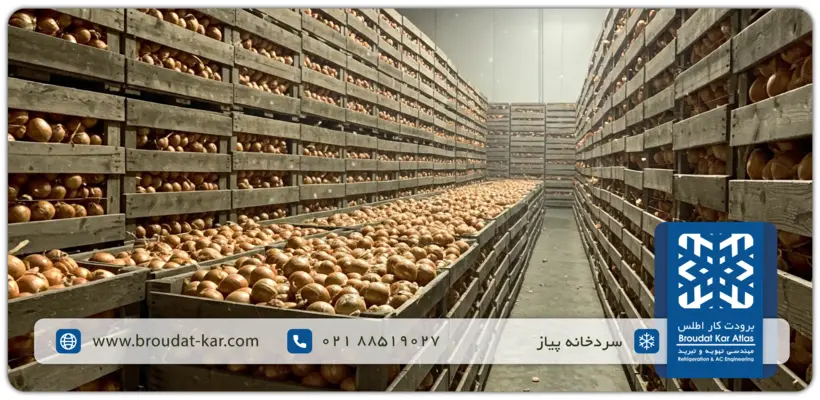 At present, by using onion cold storage, this product can be kept intact for up to 9 months; however, due to onions’ high sensitivity to improper humidity and temperature, they are among the highest-risk products for long-term storage. For this reason, strict attention must be paid to the standards for the design and implementation of onion cold storage facilities.
At present, by using onion cold storage, this product can be kept intact for up to 9 months; however, due to onions’ high sensitivity to improper humidity and temperature, they are among the highest-risk products for long-term storage. For this reason, strict attention must be paid to the standards for the design and implementation of onion cold storage facilities.
Types of Onion Cold Storage
The temperature and humidity of an onion cold storage vary depending on the onion type; therefore, each type of onion requires a cold room with different conditions. For example, green onions, sweet onions, and others must each be stored in a cold room suited to their specific standards. Below, we examine the types of onion cold storage based on their functions.
Onion Processing and Preparation Cold Storage
One type of onion cold storage is the onion processing cold room. Since onions cannot be placed in cold storage immediately after harvest, they must be processed or prepared before entering the cold room; this work is carried out in the processing cold room.
In this facility, onions are dried for several days (under ideal conditions with proper ventilation, surface drying typically takes 7 to 10 days) to prepare them for long-term storage in the cold room. For this purpose, the onions should not be cooled rapidly; rather, their temperature should be reduced gradually—by up to 0.5 °C per day—until it reaches the standard storage temperature in the cold room.
It is worth noting that ventilation plays a very important role in onion storage; therefore, appropriate equipment for air circulation must be used in the cold room. After storage, onions are not shipped directly from the cold room to market; instead, they are warmed under controlled conditions to prevent moisture condensation.
Onion Storage Cold Room
After the onions have been processed, they are stored in a cold room. In this type of facility, specific temperature and humidity conditions are set according to the onion variety. For example, dry, pungent onions should be kept at 0 °C with 65–75% relative humidity. The storage conditions in these cold rooms are adjusted in such a way as to prevent sprouting, decay, and discoloration.
Advantages of Onion Cold Storage
What are the advantages of using onion cold storage for producers?
- Extended storage life: Dry, pungent onions can be stored for up to 9 months and mild onions for up to 3 months without loss of quality.
- Prevention of sprouting and rooting: Processing or pre-cooling and storing at the proper temperature prevents onions from sprouting.
- Preservation of quality and freshness: Controlled humidity and temperature prevent yellowing and decay and also curb weight loss.
- Reduced waste and product loss: Storing onions in cold rooms reduces waste.
- Ability to supply during shortage seasons: Storing onions at harvest and selling when prices rise can multiply profitability.
- Price stability in the market: Cold storage helps stabilize onion prices.
- Improved transportation and distribution: Onions kept in cold storage face a lower risk of spoilage and are shipped to various markets at the right time.
- High-quality export potential: Storage under optimal conditions ultimately preserves quality and increases export opportunities.
- Lower transportation costs: Locating cold storage near farms and markets reduces transport costs.
- Increased efficiency and reduced producer costs: By storing their product, onion producers/farmers can manage their income more effectively.
How to Package Onions for Depot Storage
One of the key questions for onion producers is how to store onions. To stockpile or warehouse onions, special attention must be paid to storage practices—particularly the packaging method. There are several ways to package onions. One method is to use plastic mesh sacks. Owing to their structure, these sacks allow good airflow around the onions so they receive adequate cooling. Try to avoid piling onions on top of one another in the cold room; otherwise, the onions in the lower layers may rot quickly. It is also advisable to place the onion sacks on racks with proper spacing between them.
Another method of packaging onions is to use plastic crates. However, if you intend to use these crates, they must be placed 3 to 4 centimeters apart. Using crates is suitable for cold rooms that do not have shelving.
Storage Conditions for Onions in Cold Storage
The storage temperature and humidity for onions in cold rooms depend on factors such as the onion variety. In the table below, the conditions for industrial onion cold storage are provided according to onion type.
| Additional details | Storage Duration | Relative humidity (%) | Temperature (°C) | Types of onions |
| In polyethylene-covered containers, quality is maintained for one month Temperatures above 5°C cause yellowing and rot | 3-4 weeks | 95-98 | 0 | Green onions (bunched) |
| High temperatures cause sprouting. Also, high humidity accelerates rooting | 6-9 months | 65-75 | 0 | Dry onion (spicy) |
| They are stored in regular warehouses with circulating air or in refrigerated cold rooms | 1-3 months | 70-75 | 0-5 | Mild or sweet onion |
Note: One of the most critical conditions for storing onions in all types of cold rooms is proper ventilation and fresh-air circulation. Typically, if adequate ventilation is lacking, onions release ethylene gas. The removal of this gas from the onions accelerates their sprouting; therefore, fresh air should flow effectively throughout all areas of the cold room.
Onion Cold Storage Equipment
To build an onion cold room—especially an onion cold room intended for export—high-quality, appropriate equipment must be used. For example, a standard cold room requires equipment such as a compressor, condenser, evaporator, expansion valve, air-circulation and ventilation components like fan coils and dampers, as well as lighting and control equipment such as an electrical control panel, and temperature and humidity controllers, and so on.
Construction of an Onion Cold Room
In this section, we will review—step by step—the stages of building an onion cold room.
Study and Assessment
At this stage, the project requirements must be defined precisely. This includes determining the volume and capacity of the cold store based on the quantity of onions produced or imported, reviewing the allocated budget, selecting a suitable site for construction with regard to access, infrastructure, and climatic conditions, and becoming familiar with the regulations and standards governing onion cold-store construction. Thorough and comprehensive preliminary studies form the foundation for the project’s success.Design
After the preliminary studies, the cold-store design begins. In this phase, technical drawings—including plan, section, and execution details—are prepared, along with the technical specifications for refrigeration, ventilation, and humidification equipment, and cost estimates for construction, equipment, and installation. Meticulous, engineering-driven design is crucial, as it determines the quality and performance of the cold store.Contractor Selection
Choosing the right contractor for project execution is a critical step. The contractor should have sufficient experience and a proven track record in building onion cold stores, as well as the necessary equipment and manpower. Reviewing the contractor’s credentials and ensuring the presence of specialized, experienced teams across relevant disciplines are essential actions at this stage.Permitting
To construct an onion cold store, the necessary permits must be obtained from the competent authorities—such as the Ministry of Agriculture Jihad, the Ministry of Industry, Mine and Trade, the National Standard Organization, and other relevant bodies. These permits ensure compliance with applicable standards and regulations.Construction and Execution
Once permits are obtained, the project proceeds to construction and implementation. This stage includes building the structure (erecting the hall or cold-room chambers), thermal insulation, installing and commissioning the refrigeration, ventilation, and humidification systems, conducting the necessary tests to verify correct operation, and rectifying any deficiencies or faults in the cold-store systems.
- Maintenance and Repairs
After the construction and commissioning of the cold store are completed, it must be maintained and serviced regularly to extend its useful life and prevent problems and breakdowns. Carrying out regular inspections, performing preventive maintenance, and observing safety precautions during cold-store maintenance and repairs are among the essential measures at this stage.
Onion Cold Storage Construction Cost
The cost of building an onion cold storage facility depends on several factors, including storage capacity (tonnage), dimensions of the cold room, the type and brand of equipment, as well as overall economic conditions and the exchange rate.
However, you can reduce setup costs by taking advantage of Atlas Refrigeration’s free professional consultation services
At Atlas Refrigeration, we help you design and build a customized cold storage facility that meets your exact needs — at the best possible price and without unnecessary expenses. We are committed to using advanced technology and world-class brands in the installation and commissioning of all types of cold storage systems, whether small-scale or industrial.
Purchasing an Onion Cold Storage System
When purchasing an onion cold storage facility, it is important to consider several key parameters such as geographical location, available budget, manufacturer’s experience, storage capacity (tonnage), the ability to obtain necessary permits, and the required storage duration for the onions.
In this regard, one of Atlas Refrigeration’s main services is providing expert consultation before purchase to help you make the best investment decision. In addition, all of our products and installations come with a warranty and comprehensive after-sales service.
Conclusion
In conclusion, the importance of onion cold storage goes far beyond simply lowering the temperature. When the facility is properly designed and executed, its benefits are clearly reflected in reduced waste, outstanding efficiency, and a strong return on investment. If you are seeking to establish an onion cold store professionally and in accordance with best practices, Broudat Kar Atlas, as one of the pioneers of cold-store design in the country, is ready to provide you with specialized services. To get started and receive a free consultation, simply contact our experts through the communication channels listed on the website.
Yes, adequate ventilation is essential to prevent the accumulation of ethylene gas and to reduce excess humidity.
If standard temperature and humidity are maintained, the flavor of the onions does not change.
By setting the temperature close to 0 °C and maintaining appropriate humidity, sprouting can be prevented.
No. Spoiled or injured onions can spread contamination throughout the cold room.
Yes. Using energy-efficient refrigeration systems and proper insulation can reduce costs.
Related posts
Onion cold storage
Valves and Control Devices in Ammonia and Freon Refrigeration Systems The variety of valves and control devices in refrigeration systems
Cold Storage Equipment Cold storage equipment encompasses a variety of machines and devices specifically designed to store perishable goods at
What is Fruit Cold Storage? A Fruit cold storage is a specialized facility designed to store fruits and vegetables
What is Industrial Cold store? An industrial cold store is a large-scale facility designed and constructed to preserve and
Cold Room Price Estimation – Year 2024 At Atlas Refrigeration, we recognize the pivotal role cold rooms play in diverse
